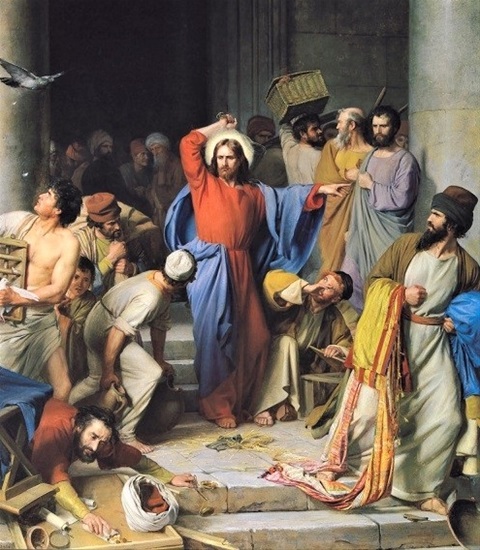April 16, 2019: TUESDAY IN THE HOLY WEEK
April 16, 2019: TUESDAY IN THE HOLY WEEK
[Cleansing of the Temple]
“And Jesus went into the temple of God, and cast out all them that sold and bought in the temple, and overthrew the tables of the money-changers, and the
chairs of them that sold doves: And he saith to them: It is written, My house shall be called the house prayer: but you have made it a den of thieves.”
(St. Matth, xxi. 12-13)
To-day, again, our Savior sets out in the morning for Jerusalem. His intention is to repair to the temple, and continue his yesterday’s teachings. It is evident that his mission on earth is fast drawing to its close. He says to his Disciples: You know that after two days shall be the Pasch, and the Son of Man shall be delivered up to be crucified (St. Matt, xxvi. 2).
On the road from Bethania to Jerusalem, the Disciples are surprised at seeing the fig-tree, which their Divine Master had yesterday cursed, now dead. Addressing himself to Jesus, Peter says: Rabbi, behold the fig-tree, which thou didst curse, is withered away (St. Mark, xi. 21). In order to teach us that the whole of material nature is subservient to the spiritual element, when this last is united to God by faith, – Jesus replies: Have the faith of God. Amen I say to you, that whosoever shall say to this mountain: Be thou removed and cast into the sea! and shall not stagger in his heart, but believe, that whatsoever he saith shall be done, it shall be done unto him (St. Mark, xi. 22, 23).
Having entered the City, Jesus directs his steps towards the Temple. No sooner has he entered, than the Chief Priests, the Scribes, and the Ancients of the people, accost him with these words: By what authority dost thou these things? and who has given thee this authority, that thou shouldst do these things? (St. Mark, xi. 28)
As on the two preceding days, Jesus leaves the City towards evening: he passes over Mount Olivet, and returns to Bethania, where he finds his Blessed Mother and his devoted friends.
Prayer (Collect).
O Almighty and everlasting God, grant that we may so celebrate the mysteries of our Lord’s Passion, as to obtain thy pardon. Through the same Christ our Lord. Amen.
EPISTLE.
Lesson from Jeremias the Prophet. Ch. xi.
In those days: Jeremias said: Thou, O Lord, hast shewed me, and I have known: then thou shewedst me their doings. And I was a meek lamb, that is carried to be a victim; and I knew not that they had devised counsels against me, saying: Let us put the wood on his bread, and cut him off from the land of the living, and let his name be remembered no more. But thou, O Lord of Sabaoth, who judgest justly, and triest the reins of the heart, let me see thy revenge on them; for to thee I have revealed my cause, O Lord, my God!
Again, we have the plaintive words of Jeremias: he gives us the very words used by his enemies, when they conspired his death. It is evident, however, that the Prophet is here a figure of one greater than himself. Let us, say his enemies, put wood upon his bread: that is, let us put poisonous wood into what he eats, that so we may cause his death. This is the literal sense of these words, as applied to the Prophet; but how much more truly were they fulfilled in our Redeemer! He tells us, that his Divine Flesh is the True Bread that came down from heaven. This Bread, this Body of the Man-God, is bruised, torn, and wounded; the Jews nail it to the Wood; so that, it is, in a manner, made one with the Wood, and the Wood is all covered with Jesus’ Blood. This Lamb of God was immolated on the Wood of the Cross: it is by his immolation, that we have had given to us a Sacrifice, which is worthy of God; and it is by this Sacrifice, that we participate in the Bread of Heaven, the Flesh of the Lamb, our true Pasch.
GOSPEL
Today, the Church reads the history of the Passion according to St. Mark, who wrote his Gospel the next after St. Matthew: hence it is, that the second place is assigned to him. His account of the Passion is shorter than St. Matthew’s, of which it would often seem to be a summary; and yet certain details are peculiar to this Evangelist, and prove him to have been an eye-witness. One should be aware that St. Mark was the disciple of St. Peter, and that his Gospel was written under the very eye of the Prince of the Apostles.
Click here, to read the Passion of Our Lord Jesus Christ according to the Gospel of St. Mark.
Taken from: The Liturgical Year - Passiontide and Holy Week, Dublin, Edition 1870.
Related Links –
1. The Passiontide and Holy
Week.
2. The Holy Season of Lent.
3. Laws of Fasting and Abstinence.
4. Perfect Contrition.
5. The
Seven Penitential Psalms.
6. Devotion
to our Lord’s Passion.
7. Devotion
to our Lady’s Sorrows.
Glory be to thy patience, O Lord!
